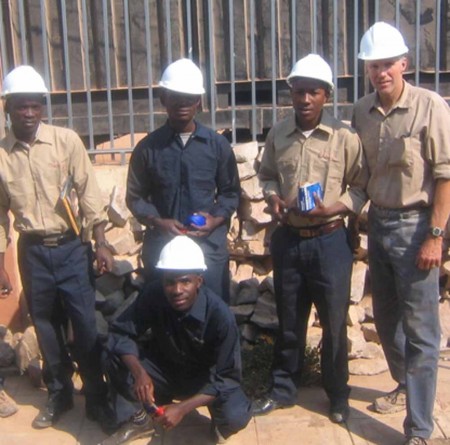
Gregory and his son, Karl, went on a trip to Kuito, Angola, Africa to train six men on how to drill water wells. Prior to taking the trip, Gregory said his pastor had taken a couple of well drillers over to Africa to train the men. The pastor became ill and could not go, so Gregory and his son volunteered.
Since Gregory and his son knew Portuguese, they would be able to communicate with the men they were training. When Gregory and his son arrived, he saw one of the men happened to be wearing a grey polo with a logo that read “Ferris State University.”
“I couldn’t believe it,” Gregory said. “I looked at that shirt, and believe it or not, my wife had bought me one just like it at Goodwill three weeks before that. I had the same exact type of shirt and everything.”
Gregory and his son are both Christians. He said, “I believe the Lord works things together for me, it’s a mystery.” He could not consider it as a simple coincidence.
The idea for Gregory to share his story with the Ferris community was after he shared several of his stories with a student from the Congo, which is north of Angola. He and the student were talking about Africa while he was teaching a statistics class.
Since statistics deals with probability and likelihoods, Gregory thought the Ferris community might appreciate how very unlikely it was the man would be wearing the grey polo with the Ferris State logo due to chance.
“There were probably a couple million shirts, a lot were sent over there. I felt it was appropriate to share that story with the class because it was a statistics class, this is a Ferris story when you get right down to it,” Gregory said.
The topic of the shirt led to another issue: cell phone use while working. Gregory came across this when he realized the men had their cell phones out while they were working on the wells.
“The idea came with how to deal with the cell phone issue, because I realized, oh wow, the fact that I do teach at Ferris and my students have cell phones, here’s the chance for students to teach these guys what proper protocol is,” Gregory said.
He said American students followed protocol and did not use their cell phones during class. After Gregory told the men that, he said, “I never saw another cell phone while they were working, they just did not bring them out.”
Gregory said it was a good example of how to get people to do the right thing. He said he explained to them how Ferris students in the United States did certain things, and the habits of what Americans do carry a lot of weight in other places in the world.
He asked the men, “How much work do you think we’d get done while using cell phones?”
The men arrived with a one-word answer: nothing.
“They all realized this is not a place for cell phones,” Gregory said. The fact they arrived at that conclusion was the big lesson.
In 2006, Gregory said it was rare for a student to even touch their phone in class. Now, it’s common for students to be on their phone during class.
“It does seem like students will pull their phones out and start texting and checking the Internet and whatever during class, it’s become a distraction,” Gregory said.
Back in 2006, he told the men American students wait to check their cell phones in between classes.
“By the way, I and my colleagues wish this were still true,” Gregory said.
After the cell phone use issue was taken care of, Gregory said the men did especially well in their training.
